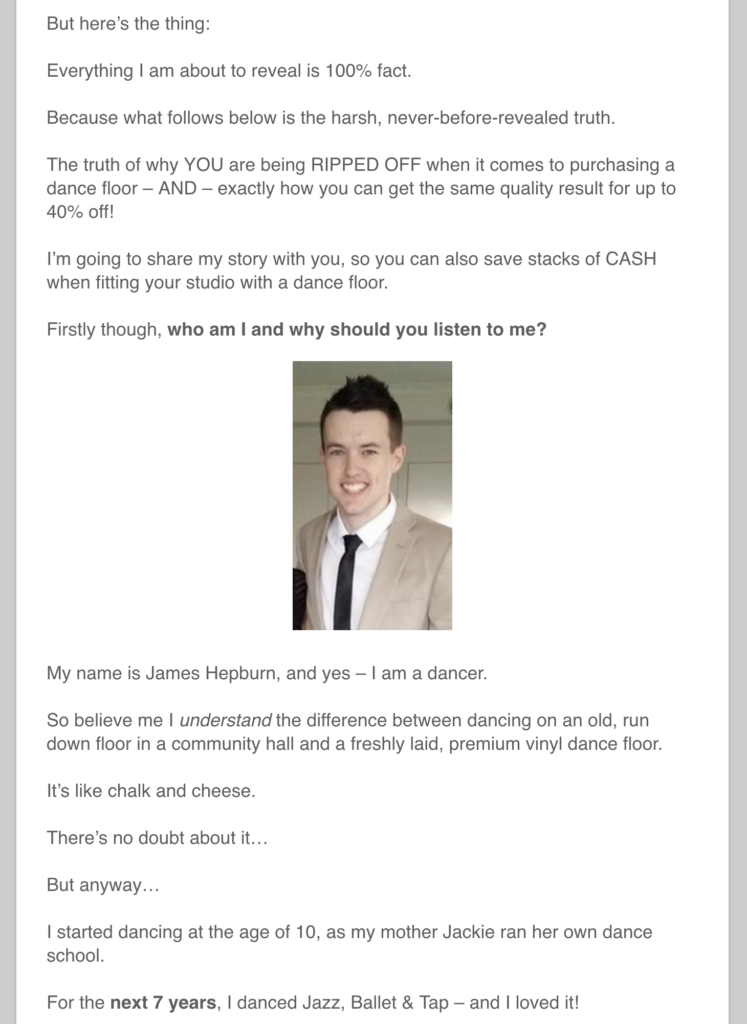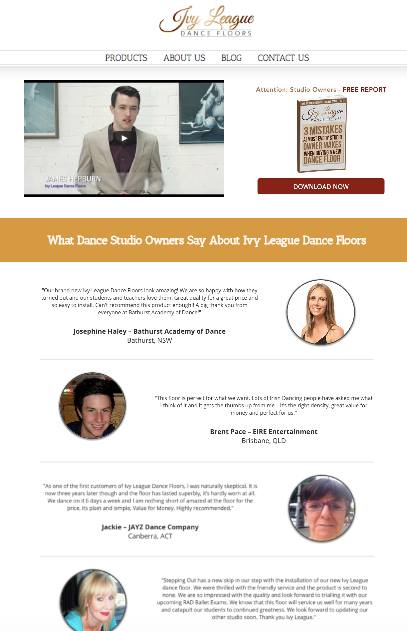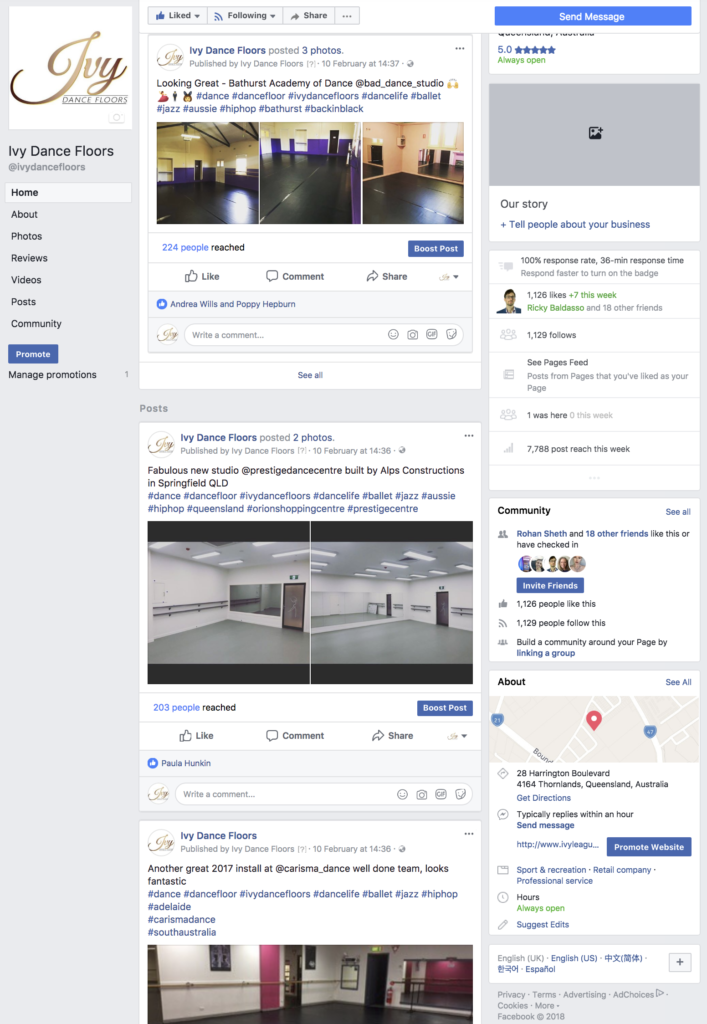Today, I want to talk about the 13 lessons I learned from building Ivy Dance Floors into a $400,000 side business. I’m going to talk about everything from the sales letter I wrote, to how we approach competition and the mistakes we made.
I even talk about the wars I wish I started – but I’ll get to that in just a moment.
This business is something I’m incredibly proud of. In a lot of ways, I feel like its my Superbowl ring. You see, when my brother Geoff and I started this business, we were in a position where we were financially in a hole for more than $200,000.
No joke.
We were running a business that was heading under – yup, towards bankruptcy… and we reached a critical point where we had to make a decision.
Do we invest our time and resources into growing that business? Or were we going to do whatever we could to make money.
If you’re reading this, I hope you are never faced with this decision. It was an incredibly stressful time in my life. In saying that – I’m totally grateful for it. I wouldn’t be who I am without it.
Luckily, we took the second option… and it turned out for the better.
Because once we got out of that business, which I’ll talk more about in this post… Let me get straight into it – here are the 13 lessons I learned:
#1 – The Power of a Good Offer
In 2014, my brother and I ran a business called The Bicycle Store. It still runs today.
And it’s not that it necessarily had bad offers, they were just the same products as every competitor. When we started selling vinyl dance floor, which you can read more about here, we were only competing with about 4 suppliers in Australia.
But we had something unique, the exact same product as our competitors, but for significantly less money.
My mum wanted this vinyl flooring in her studio. She’d been quoted $7,500 for 110m2 delivered to her studio in Canberra. I got the same product landed in her dance studio for $2,250.
When she was really happy with it, I had an epiphany…. and to quote Jeff Bezos – “Your margin is my opportunity.”
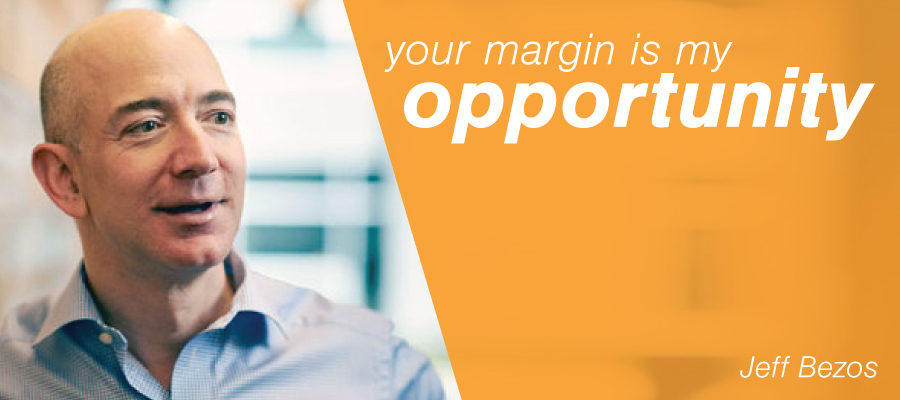
That $5,250 margin difference was our opportunity and if we wanted to – we could take on every competitor in the market. Even though every competitor was an established brand, there was a lot of room to play.
Naturally, when we started pricing our product at $25 less per square metre, we instantly had interest in our product and generated sales.
So, never underestimate a good offer.
It might be the price, benefits, risk reversal, features or uniqueness. But at the end of the day, your customers are buying the actual offer.
Nothing else will compensate for it.
#2 – Good Marketing is King
Having an offer is great… but how are you hooking people in?
How are you attracting them?
How are you polarizing the market?
How are you creating a message that really gets them excited about what you’re doing and gets attention?
Something I did very well in this market, is that I created attract & repel marketing.
I went out with a very strong marketing message and stated what I believe to be true: every supplier of dance floor in the Australian market was, and still is, ripping off their customers.
You know, most dance studio owners are like my mum.
They’re just mum and dad operators who don’t have a lot of cash and teach dance because they love it. And I just firmly believed they were getting ripped off.
So my marketing message was shaped around that. The first campaign I ran was called:
“The Harsh Truth About Vinyl Dance Floors”
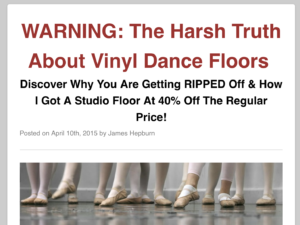
Good marketing polarizes an audience.
It brings in the people you want and repels the people you don’t want. I wrote our first sales letter as a story about me, with my face and name attached to it. It was a very aggressive and controversial message – which you can read here.
Now… that’s on the internet forever. And I don’t have any issue with it.
When I believe in a cause, I’ll sing it from the rooftop – just as every business with a great product should.
Good marketing is crucial. Polarise your market. Attract the customers you want, and repel those you do not.
When you have good marketing, you’ll be a market leader.
#3 – Margin is Important
Before we started Ivy Dance Floors, my brother and I ran an online retail business on the Magento platform.
Not only were the margins horrendously bad, but our overseas competitors could sell the same products as us at retail for cheaper than we could buy them wholesale.
It was pure madness. We were in a price war and we got absolutely slaughtered.
When it came to Ivy Dance Floors, we could produce a high quality product for a low price in China. This meant we could maintain a good margin and still provide cheap prices to our customers.
Having a good margin isn’t just about making money. It’s about funding your growth and making sure you can survive times in business when your sales and cash flow are sporadic.
Some months we’ve made great money, some months we haven’t. But having solid margins allows you to pay for expenses and reinvest in stock and other assets.
To summarise – not having a decent margin will choke your business.
#4 – Validate an Idea before you Spend a Cent
It definitely helps when your mother is your ideal client.
Our mum was our first customer, so we bought the product for her dance studio in Canberra. 3 years later – it’s still there.
On the Easter long weekend in 2015, we installed it. This was around the time the business kicked off. Once mum approved of it and loved the product – I knew there would be hundreds of other studio owners lining up to buy it.
So, I wrote an ad and put it on Gumtree. Said, “Hey, I’ve got 20m x 1.5m rolls of vinyl dance floor, it’s $1,200 per roll.”
Almost instantly, people started to eat it up. I got like 5 calls in a week.
At the time, I didn’t even have any stock. I just said, “I’ve sold out. We’re ordering some in. I’ll ring you when I get it.”
Because I got that proof, I went home and wrote this sales letter you can read, and that’s still running today – 3 years later.
A week later… emails started flooding in. We were so broke at the time, it was like a beacon of hope. I’ll never forget it:

When it went live, I had people emailing and ringing my phone off hook – all interested in it.
Given how broke we were at the time, we borrowed about $4,000 from our parents and imported 10 rolls.
Sold the 10 rolls for $12,000 within the first week of receiving them. Paid our parents back and the business took off from there.
The key is however – validate the idea you have before wasting money. Trust me, from having done the wrong thing many times – it’s far more expensive that way.
#5 – You are One Sales Letter Away
I could talk about this all day.
Russell Brunson talks about being ‘one funnel away’. And I actually hate that, because it’s such a fantasy for most people. But it’s the same with sales letters.
When I first got into writing copy, everyone talked about being one sales letter away from a million dollar business.
And the crazy thing is… it’s true.
One of the reasons this business hasn’t grown more is because it’s always been a side hustle.
I run my marketing company. My brother runs an electrical company. But the reality is, it could be a much bigger business.
And one of the main reasons, is this sales letter I wrote. Here’s and excerpt from it:
There are 5 key reasons this worked well – they are:
#1 – Everything I wrote in the letter is true. Whilst its opinionated, it’s very hard to disagree with.
#2 – It’s very controversial and polarizing. By the time you get to the end, you are either going to love me – or absolutely hate me. I’m fine either way. I know my truth.
#3 – I told a story that elicits emotion from my market. I justified their failures and allayed their fears. Very important when you want to convince someone why they should work with you.
#4 – I made them an absolutely killer offer. Our dance floor is like 40% cheaper than out competitors. As most studio’s need a lot of flooring, this results in a saving of thousands.
#5 – I had proof to back it up. There’s testimonials on the page. At the start it was only a handful and I probably need to add more. Over time I added the company introduction video to build more trust.
If you can find an underserved niche and present to them a new opportunity, a way to generate the results the way with a huge benefit, and you connect to them authentically – you literally can’t lose.
#6 – Don’t be Cheap
This is a true story. It’s kind of funny, although very serious, and a great lesson.
When we were living in Sydney, we had storage space below our bike shop where we stored stock.
When shipments of Dance Floor came in, Geoff would hire a truck, pick them up from the dock and bring them back to our shop.
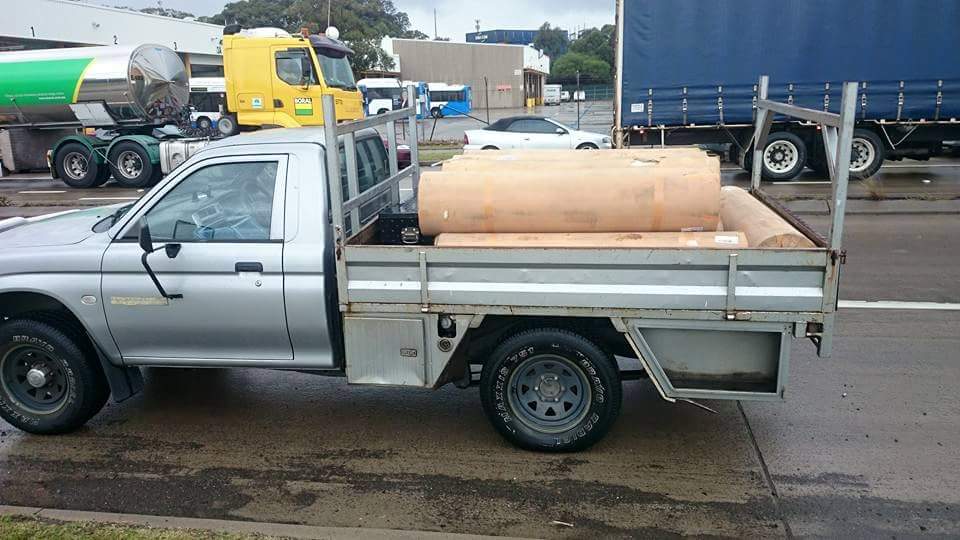
As we soon learned, we would have been far better off paying a transport company to deliver the stock to us.
But we were so broke at the time we would do anything to save $200 – $300.
Anyway, so one day in the middle of 2015, Geoff went to pick up the second load of 70 rolls we had ordered in – around 7 tonnes of cargo.
He tied it all into the truck but when he took off, the actual pallet the rolls were sitting on snapped and the dance floor flew out all other the road.
6 rolls were damaged.
He called me and said, “I need you to get down to this intersection asap. Shut the bike shop. Come.”
I raced down there, and I remember Geoff was in the back of the truck trying to hold the rest of the rolls up to prevent more from falling out and getting damaged.
When I got there and jumped in the back, we were moving the rolls around to re-order them, when one roll fell over the side.
Geoff just reached out and grabbed it, and as he held onto it, a scooter rider came around the corner and rode past. Had Geoff not stopped itl from falling, this 100kg roll of vinyl floor would have hit and probably killed the guy on the scooter.
So, we were lucky nothing happened and there was no more damage done. But, yeah, don’t be cheap. That’s one of many examples in business. The dearest way is the cheapest way.
#7 – Don’t be Addicted to a Fantasy
Business is hard. There’s no doubt about it. And I’m not trying to make it seem easy with these headlines I write, or any of the content. It’s hard work.
We were lucky that we had all the warehouse space and didn’t have to pay any additional rent when we launched.
But lucky is a relative term. We were also in a lot of debt, under a tonne of financial pressure and living with a lot of stress.
I wouldn’t wish it on anyone, but it made me who I am, and put me in a position where I can do what I do today.
Even now, whilst the business has done well financially, we’ve never made a cent from it.
To be fair, Geoff runs the business these days. I’m very passively involved in it and happy for it to be that way.
I started it, launched it, made all the first sales, and was heavily involved for about the first $100,000 of revenue.
But all the money that we’ve made has either been reinvested into the growth of the company, or to paying off debt from the bike shop.
We took massive risks along the way too.
After we ordered sold the first 10 rolls, we needed $25,000 to get 70 rolls and Geoff rang a friend who had money and asked him for a loan if he could pay him back at a premium.
Luckily he agreed. But it was a crazy risk at the time when we already had a lot of debt. Geoff was never worried about it thought, he backed what we were doing and has a really solid appetite for risk.
But anyway. Don’t romanticise with entrepreneurship. Business is difficult.
#8 – Direct Response First, but Brand is Important
Everything I do in marketing is direct response with the intention of driving a monetary ROI whether its a sales letter, content piece or video.
I’m always trying to elicit an emotional reaction from my audience and drive them to take action, whether that’s buy, enquire or even engage in my content. It’s crucial. If you’re not running direct response marketing, you’re wasting time and money.
But also understand that brand is important.
We’ve sponsored dancing events and competitions, been featured on magazine covers and even ran ads on dance media websites. We actually had an ad get banned because our competitors complained.
Unfortunately I wasn’t surprised, as usual my ad was aggressive and controversial.
So always remember – direct response is king, but brand is important. We got exposure from some of the branding we have done, that helped get our name out in the market.
And whilst it’s hard to measure the ROI of that, I have no doubt people discovered who we are from the things we’ve done.
#9 – Be Careful with Names
When we started out, we called the business Ivy League Dance Floors – which is a name Geoff came up with. Ivy League was from the top 8 American Colleges: Yale, Stanford, Harvard, Brown etc.
We liked the eliteness of the name and thought it was a great branding play. I actually named my marketing company Ivy League Marketing not long after.
Well… that was until we got served a cease and desist letter by the Ivy League Corporation in the U.S. for infringing their trademark:
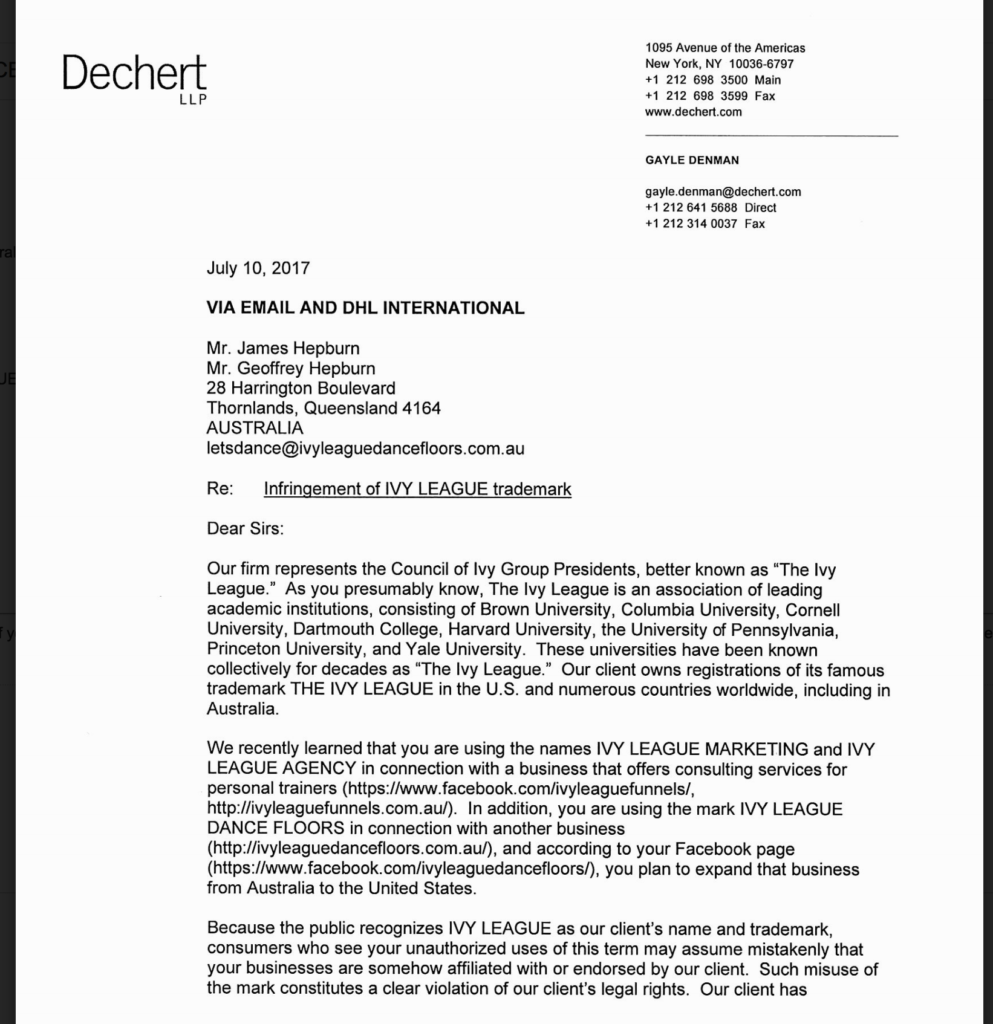
So, be careful with names. The business is now called Ivy Dance Floors. This could have been significantly worse if we had to change to a totally different name after working hard to build the brand.
#10 – Don’t Worry about Websites and Shit that Doesn’t Matter
We had no website for probably the first $50,000 in revenue. Then we just built one that was absolutely terrible.
Geoff’s just had a new one built. Which for the record, I have written no copy for. I feel the need to heavily express that.
Don’t worry about websites or anything like that. It does not matter. Do you have something valuable that your market will pay you for? Then sell it.
We had t-shirts and business cards made once we started sponsoring events. But even then, we would spend a few hundred bucks on basic stuff once we’d made $50,000 to $100,000.
Majority of business owners worry about this stuff far too early.
The very first thing I did was test the product with my mum and write a sales letter to make money – because that’s all that matters.
#11 – Share Results
Always share the results of your customers publicly. One thing Geoff does really well is posts photos of every single install he does on our Facebook Page:
It’s just further proof that shows our market we’re actually out there doing it.
We’ve supplied over 50 dance studios now and have a tonne of customer proof. Its really important to share the results your customers are getting.
The floor looks amazing every time its installed – which helps sales just as much as the first letter I wrote.
#12 – Keep the Product Offering Simple
From over $400,000 in revenue, we’ve only got 2 products.
In fact, It’s the exact same product – our 4mm thick vinyl dance floor – but it comes in two colours; grey and black.
The biggest mistake I see people make is they offer too many different products when they have no revenue.
Find one good offer for an underserved market, and you don’t need to sell anything else. Not until you starting making bank anyway.
#13 – Starting Wars
I strongly believe that every good business stands for something and has an enemy. For Ivy Dance Floors, our enemy is our competitors but not in a traditional way. They’re the enemy because they’re ripping off hapless dance studio owners.
Ivy Dance Floors stands for the mum and pop dance studio operators – just like our mother. The people who want to create an awesome environment for kids to learn dance. They aren’t necessarily trying to make a million dollars – but if they do, more power to them. They run a dance school because they love it.
They are the people we cater for.
Apple – a truly great business founded by Steve Jobs – is about going against the status quo. We’re for the square peg in a round hole. The troublemakers, misfits and rebels.
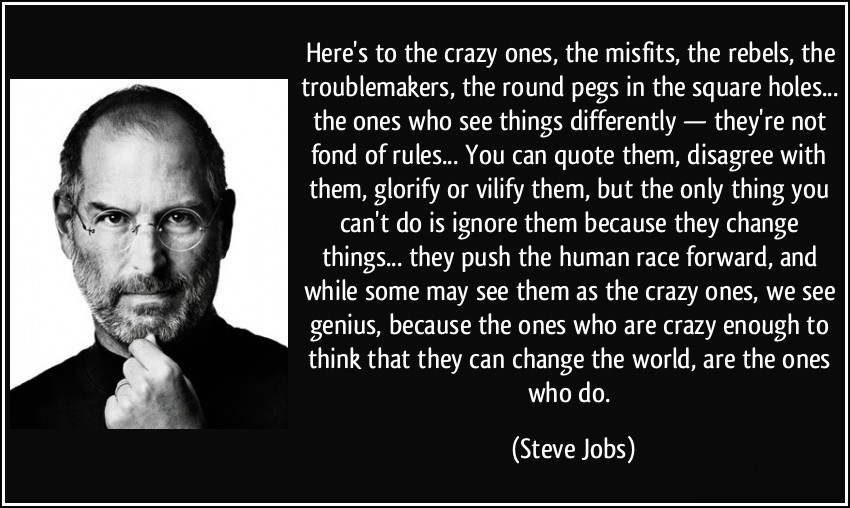
The Entourage, an education company for entrepreneurs and business owners, fight a war against traditional education. They want to help empower entrepreneurs to live a live on purpose.
Kogan, the online retailer, are a rebel upstart against traditional bricks and mortar retail businesses. Kogan took out full page newspaper ads against Jerry Harvey and Harvey Norman.
Ruslan Kogan did crazy stuff that I probably wouldn’t do. All because his business had an enemy and he wanted to prove a point.
It’s so important to start wars. They show the market who you stand for and who you are against. It creates controversy, polarity and entertainment… all which gives your business more attention.
Very early on in this business, when I launched the first sales letter… the general manager of our biggest competitor rang my personal phone and pretended to make an enquiry.
When he told me his address and asked if I could send him a sample… I knew exactly who he was.
So I just called him out on the phone, in a non threatening way, and said, “I know exactly who you are, and I know what you’re trying to do”. He hung up the phone and rang me back 30 minutes later and asked for a sample… because we had got a sample from them earlier on.
He was actually really nice. But for some reason, I backed down as a result of that – which I regret.
The reason I didn’t press harder at the time was… I didn’t want competitors knowing what we were doing. We were very, very small… and this was early days. Whilst Geoff was totally unaffected by it, I wanted to take the business offline more, and do direct mail.
The reason direct mail is great is – no competitor knows what you are up to.
So anyway, we pressed on. But at the end of 2015, my first mentor Mitch Miller came to Australia and I told him the story.
He called me out on not, what he called, “starting a full blown war”. Mitch told me the biggest mistake I made was not putting my foot on their throat and calling out every competitor.
He told me:
“Creating a controversy about how your biggest competitor was challenging you would have created a giant talking point in your industry and the business would have exploded.”
So, you live and learn. I don’t regret it. Being controversial is tough… if you wanna get in the kitchen, you need to be ready for the flames.
Anyway… this one was pretty long.
These are the main 13 lessons I learned from building a $400,000 side business from one single sales letter.
Hope you got something out of that. Enjoy.


